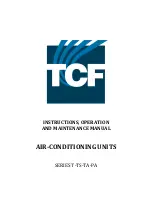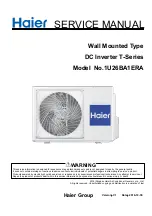
9
5. Electrical work
1
A
Fig. 5-7
AB
TB6
B
2) Connecting procedures (Fig. 5-7)
1
Connect the remote controller cord to the terminal block.
A
To TB5 on the indoor unit
B
TB6 (No polarity)
3) Temperature display setting
The initial temperature display setting is °C. Please change the setting to °F. Refer to
“Function selection of remote controller (Section 8)” in the operation manual for the
indoor unit.
4) Two remote controller setting
If two remote controllers are connected, set one to “Main” and the other to “Sub”. For
setting procedures, refer to “Function selection of remote controller” in the operation
manual for the indoor unit.
A
ON/OFF button
B
Test run display
C
Indoor temperature liquid
line temperature display
D
ON/OFF lamp
E
Power display
F
Error code display
Test run remaining time
display
G
Set temperature button
H
Mode selection button
I
Fan speed button
M
TEST button
Fig. 6-1
6. Test run
6.1. Before test run
s
After completing installation and the wiring and piping of the indoor and
outdoor units, check for refrigerant leakage, looseness in the power supply
or control wiring, wrong polarity, and no disconnection of one phase in the
supply.
s
Use a 500-volt megohmmeter to check that the resistance between the power
supply terminals and ground is at least 1.0 M
Ω
Ω
Ω
Ω
Ω
.
s
Do not carry out this test on the control wiring (low voltage circuit) termi-
nals.
Warning:
Do not use the air conditioner if the insulation resistance is less than 1.0 M
Ω
Ω
Ω
Ω
Ω
.
Insulation resistance
6.2. Test run
The following 2 methods are available.
6.2.1. Using wired remote controller (Fig. 6-1)
1
Turn on the power at least 12 hours before the test run.
2
Press the [TEST] button twice.
➡
“TEST RUN” liquid crystal display
3
Press the [Mode selection] button.
➡
Make sure that wind is blown out.
4
Press the [Mode selection] button and switch to the cooling (or heating) mode.
➡
Make sure that cold (or warm) wind is blown out.
5
Press the [Fan speed] button.
➡
Make sure that the wind speed is switched.
6
Check operation of the outdoor unit fan.
7
Release test run by pressing the [ON/OFF] button.
➡
Stop
8
Register a telephone number.
The telephone number of the repair shop, sales office, etc., to contact if an error
occurs can be registered in the remote controller. The telephone number will be
displayed when an error occurs. For registration procedures, refer to the opera-
tion manual for the indoor unit.
Note:
• If an error code is displayed on the remote controller or if the air conditioner
does not operate properly, refer to the outdoor unit installation manual or
other technical materials.
• The OFF timer is set for the test run to automatically stop after 2 hours.
• During the test run, the time remaining is shown in the time display.
• During the test run, the temperature of the indoor unit refrigerant pipes is
shown in the room temperature display of the remote controller.
• When the VANE or LOUVER button is pressed, the message “NOT AVAIL-
ABLE” may appear on the remote controller display depending on the indoor
unit model, but this is not a malfunction.
˚F
˚F
SIMPLE
PAR-21MAA
ON/OFF
FILTER
CHECK
OPERATION
CLEAR
TEST
TEMP.
MENU
BACK
DAY
MONITOR/SET
CLOCK
ON/OFF
TEST RUN
COOL, HEAT
A
F
C
E
D B
M
I
H G
7. Installing the grille
7.1. Checking the contents
• This kit contains the following parts.
Accessory name
Q’ty
Remark
1
Grille
1
2
Screw
6
M5
×
0.8
×
16
3
Screw
1
4
×
16
7.2. Checks before setting in place
• Before installing the front panel, make sure the indoor unit is square with the ceiling
opening (or parallel to the angle between the wall and the ceiling).
• Check that the four points where the front panel will be secured are in contact with
the ceiling surface (see Fig. 7-1).
• Check that the insulation for the refrigerant pipes, drainage pipes, etc. is in place
and that wiring connections and arrangements are complete.
1
2
3
A
Points for securing the grille
B
Points for securing the grille
C
Indoor unit
D
Ceiling surface
E
Drainage pan
F
Places for securing front grille
G
Make sure these surfaces are
flush with each other 0 - 1/8 in.
(0 - 3 mm).
Fig. 7-1
A
B
C
F
G
E
D
Summary of Contents for Air-Conditioners For Building Application
Page 11: ......






























